THE ULTIMATE A&P FLASHCARD SET
0.0(0)
0.0(0)
Card Sorting
1/118
Earn XP
Description and Tags
this thing is brp
Study Analytics
Name | Mastery | Learn | Test | Matching | Spaced |
|---|
No study sessions yet.
119 Terms
1
New cards
_____ are harmful microscopic enemies that can cause disease
pathogens
2
New cards
what are leukocytes?
white blood cells (WBCs)
3
New cards
lymphocytes are special types of leukocytes that concentrate in _____ tissue
lymphatic
4
New cards
what are some examples of lymphocytes?
B and T cells
5
New cards
what are the two types of immune responses?
innate and adaptive
6
New cards
the _____ immune system is a **quick**, **nonspecific** immune response
innate
7
New cards
a human's outer barriers to infection (such as skin) are the **first layer** of _____ immunity
innate
8
New cards
what are some of the **outer barriers** which are a part of **innate** immunity?
thick epidermis; dermis; hypodermis (subcutaneous); mucus membranes; sebaceous glands
9
New cards
**mucus membranes** in the skin function to secrete _____ and trap pathogens
lysozyme
10
New cards
how do lysozymes function?
they **nonspecifically** break down bacterial cell walls
11
New cards
**sebaceous glands** of the skin secrete _____, which serves as **physical** barrier
oil (sebum)
12
New cards
what are the properties of fatty acids in sebum?
they are antimicrobial and nonspecific
13
New cards
what are cilia?
hair-like projections that sweep away unwanted invaders
14
New cards
stomach acid is an _____ barrier of the innate immune system, which _____ (specifically/nonspecifically) kills microbes with **low** **pH**
external; nonspecifically
15
New cards
_____ bacteria are allies that out-compete their more hostile relatives, and are an _____ (internal/external) barrier to infection
symbiotic; external
16
New cards
what are the steps of the **innate immune** response after the physical barriers are penetrated?
1. Alarm, enemy detected - activation of inflammatory response
2. Rally - recruitment of immune cells to site of injury
3. Battle - immune cells attack pathogens
4. Backup - activation of complement system
17
New cards
mast cells are a type of _____ that sits in tissues
leukocyte
18
New cards
injured tissue and mast cells work together to release _____
histamine
19
New cards
how does histamine function?
it dilates capillaries and makes their walls more permeable near injured vessels, which brings more blood to the injury
20
New cards
why is histamine's function essential?
it allows fluid and immune cells to leak out to the site of injury \n \n (inflammatory response)
21
New cards
what are the five signs associated with **inflammation**?
Swelling \n Loss of function \n Increased heat \n Pain \n Redness \n \n (SLIPR)
22
New cards
heat is an inflammatory sign, which results from _____ and _____
dilation of capillaries; increased blood flow
23
New cards
_____ is an inflammatory sign, which occurs due to the **dilation of capillaries**
redness \n \n (more blood = red color)
24
New cards
_____ is an inflammatory sign that occurs by **permeable capillaries**
swelling \n \n (fluid accumulation)
25
New cards
what causes sharp pain at the time of injury?
nerve endings
26
New cards
_____ is felt after the time of injury, and it is due to **inflammation**
slow, throbbing pain
27
New cards
what are the **indirect** outcomes of inflammation?
**loss of function** due to swelling and pain
28
New cards
_____ is a systemic response to hinder the growth of (or kill) pathogens
fever
29
New cards
_____ is the passage of leukocytes through the unruptured wall of a blood vessel during inflammation
diapedesis
30
New cards
what is chemotaxis?
the process of moving to a location in response to a chemical signal
31
New cards
what are the five types of leukocytes in order of abundance?
**(Never Let Monkeys Eat Bananas)**
**Neutrophils**
**Lymphocytes**
**Monocytes/Macrophages**
**Eosinophils**
**Basophils**
**Neutrophils**
**Lymphocytes**
**Monocytes/Macrophages**
**Eosinophils**
**Basophils**
32
New cards
_____ are the most numerous leukocytes
**N**eutrophils (**N**ever)
33
New cards
**N**eutrophils (**N**ever) act as _____ in the _____ (innate/adaptive) immune system
phagocytes; innate

34
New cards
which **L**ymphocytes (**L**et) are innate and which are adaptive?
natural killer (NK) cells = innate; B and T cells = adaptive
35
New cards
_____ cells are innate **L**ymphocytes (**L**et) that attack and kill virus-infected cells, as well as cancerous body cells
natural killer (NK)
36
New cards
natural killer (NK) cells are innate **L**ymphocytes (**L**et) that do not require _____
activation
37
New cards
NK cells are innate **L**ymphocytes (**L**et) that secrete _____ & _____ to fight enemies
perforin; granzymes
38
New cards
which type of enzyme are granzymes and what do they stimulate?
proteases; apoptosis
39
New cards
why are granzymes important?
they eliminate virally infected and cancerous cells
40
New cards
a _____ is an enzyme that breaks down **peptides**
protease
41
New cards
_____ is programmed cell death
apoptosis
42
New cards
**M**onocytes (**M**onkeys) are a part of the _____ (innate/adaptive) response
innate \n \n (nonspecific)

43
New cards
**M**onocytes (**M**onkeys) are immature when they are in **blood vessels**; however, they mature into _____ once they cross over into an **infected tissue**
macrophages
44
New cards
what is the mechanism by which **M**onocytes (**M**onkeys) travel to infected tissue?
diapedesis
45
New cards
macrophages are mature **M**onocytes (**M**onkeys) that act as phagocytes and function as _____ to activate adaptive immunity
antigen-presenting cells
46
New cards
**E**osinophils (**E**at) are a part of the _____ (innate/adaptive) immune response
innate \n \n (non-specific)
47
New cards
**E**osinophils (**E**at) contain _____ in their cytoplasm, which can be released to kill pathogens (especially effective on parasites)
granules

48
New cards
which leukocyte is the least numerous?which leukocyte is
basophils bananas
49
New cards
**B**asophils (**B**ananas) contain _____ (like Eosinophils) and have a similar function to _____
granules; mast cells
50
New cards
what are the two important components of **B**asophil (**B**ananas) granules?
histamine; heparin
51
New cards
_____ is an **anticoagulant** component of **B**asophil (**B**ananas) granules, which prevents blood from clotting too quickly
heparin
52
New cards
**B**asophils (**B**ananas) are _____ (mature/immature) in the blood; mast cells are _____ (mature/immature) in the blood
mature; immature
53
New cards
dendritic cells use _____ to observe local environment
pinocytosis

54
New cards
**pinocytosis** is a type of endocytosis that is also known as _____
cellular drinking
\
(endo-/exocytosis are **active** transport mechanisms)
\
(endo-/exocytosis are **active** transport mechanisms)
55
New cards
dendritic cells are part of the _____ (innate/adaptive) immune system, but they travel to **lymph nodes** to activate _____ (innate/adaptive) immunity
innate; adaptive \n \n (dendritic cells are antigen presenting cells)
56
New cards
when are interferons secreted?
when cells become infected by viruses
57
New cards
_____ binds to non-infected cells to warn and prepare for viral attack
interferon
58
New cards
interferon activates _____ cells, which further activate **adaptive** **immunity**
dendritic
59
New cards
the **complement system** contains a group of _____ that help the immune cells battle pathogens
blood plasma proteins
60
New cards
what is the mechanism of the cascade series of activation?
proteins "turn each other on" through the release of **cytokines** to amplify their effect
61
New cards
the complement proteins are activated by _____ (immunoglobulin)
IgG and IgM
62
New cards
what are three things the complement system can do when it is activated?
opsonization; stronger histamine release + more inflammation; membrane attack complex (MAC)
63
New cards
which system of immunity performs **opsonization**, and what does this process involve?
the complement system; protein tags the surface of invaders, making them more prone to phagocytosis
64
New cards
describe the effects of a **membrane attack complex (MAC)** created by the complement system:
poke holes in pathogen --> fluid and salts enter pathogen --> lysis
65
New cards
if innate immunity isn't sufficient to protect against pathogens, what supplements it?
adaptive immunity
66
New cards
_____ (innate/adaptive) immunity is a **specific** immune response for **specific** antigens, and it has _____
adaptive; memory
67
New cards
an _____ is a marker that helps distinguish between self and non-self cells
antigen
68
New cards
how does the body distinguish between self and non-self cells (in addition to antigens)?
major histocompatibility complex (MHC)
69
New cards
all nucleated cells contain MHC class _____ molecules on their surface
1
70
New cards
which MHC class(es) is/are present on antigen presenting cells?
1 and 2
71
New cards
(True/False) individuals contain unique MHC 1 molecules
true \n \n exception: identical twins have the same MHC 1
72
New cards
why do transplant rejections occur?
different MHC 1 molecules will be labeled as a foreign antigen on the donor organ
73
New cards
transplant patients must take _____ on a life-long basis
immunosuppressants
74
New cards
in autoimmune diseases, the immune system attacks _____
self-cells
75
New cards
_____ act as a bridge between innate and adaptive immunity
antigen-presenting cells (APCs)
76
New cards
macrophages and dendritic cells are _____
antigen-presenting cells (APCs)
77
New cards
which MHC class(es) is/are present on macrophages and dendritic cells and why?
1 and 2; they are antigen presenting cells (APCs)
78
New cards
a(n) _____ is the section of an antigen that is recognized by immune cells
epitope

79
New cards
B and T cells are adaptive _____ (cell type)
**L**ymphocytes (**L**et)
80
New cards
what are the three main types of **L**ymphocytes (**L**et)?
NK cells (innate); B and T cells (adaptive)
81
New cards
B cells stay and mature in the _____, while T cells go and mature in the _____
**b**one marrow; **t**hymus
82
New cards
_____ are involved with antibody-mediated adaptive immunity (**humoral** **immunity**)
B cells
83
New cards
each B cell has one type of _____ that is specific for one type of antigen epitope
B cell receptor (BCR)
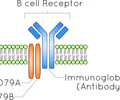
84
New cards
what happens after a B cell binds to an antigen?
it becomes activated and then divides to make copies of itself
85
New cards
describe the clonal selection model for B cells
B cells have unique BCRs to specific antigens. If those antigens are present, only the B cells with the BCR for antigen binding will amplify
86
New cards
what are the two types of cells that B cells can differentiate into?
plasma cells or memory B cells

87
New cards
what are plasma B cells responsible for?
releasing antibodies called immunoglobulins

88
New cards
plasma B cells circulate in the _____ and _____
blood; lymph
89
New cards
what is the difference between a B cell receptor (BCR) and an antibody?
one is part of a b-cell membrane, and an antibody is floatin around in yar blood
90
New cards
what are three things antibodies can do after they are released into the humor (body fluid)?
**tag** corresponding antigen for phagocytosis; **coat** the antigen in antibodies; **activate** the complement system
91
New cards
what is the shape and composition of an antibody (immunoglobulin)?
Y-shaped, consisting of a light chain and a heavy chain linked through disulfide bonds
92
New cards
describe the function of the **constant** **region** on an antibody immunoglobulin:
leads to the development of five major antibody/immunoglobulin classes \n \n (IgM; IgA; IgE; IgD; IgG)

93
New cards
describe the function of the **variable** **region** on an antibody/immunoglobulin:
different amino acid sequence for different antigen binding
94
New cards
what are the five classes of antibodies (immunoglobulins)
(Me And Eve Don't Go) \n \n IgM \n IgA \n IgE \n IgD \n IgG

95
New cards
IgM is a _____, and it is the _____ antibody
pentamer; largest
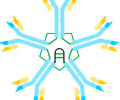
96
New cards
_____ is the first immunoglobulin made in response to an antigen
IgM

97
New cards
IgM activates the _____ (innate immunity)
complement system \n \n (IgG also activates the complement system of innate immunity)
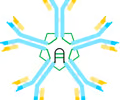
98
New cards
_____ is a dimer that is abundant in body secretions
IgA
99
New cards
IgA provides _____ immunity to newborns (breastmilk)
passive
100
New cards
IgA stops pathogens _____ before they enter circulation
externally